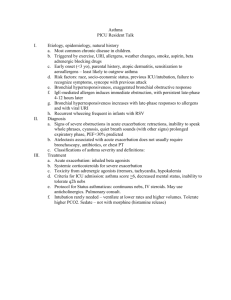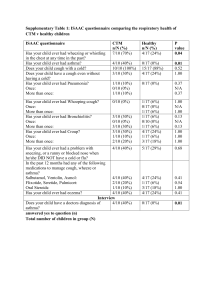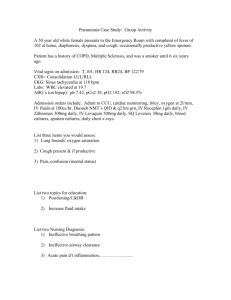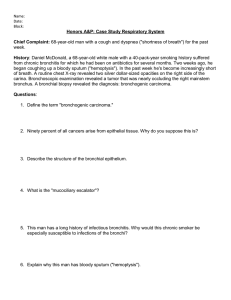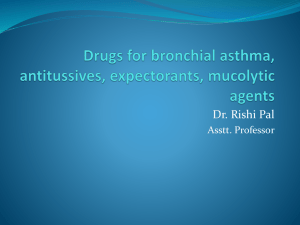asthma
advertisement
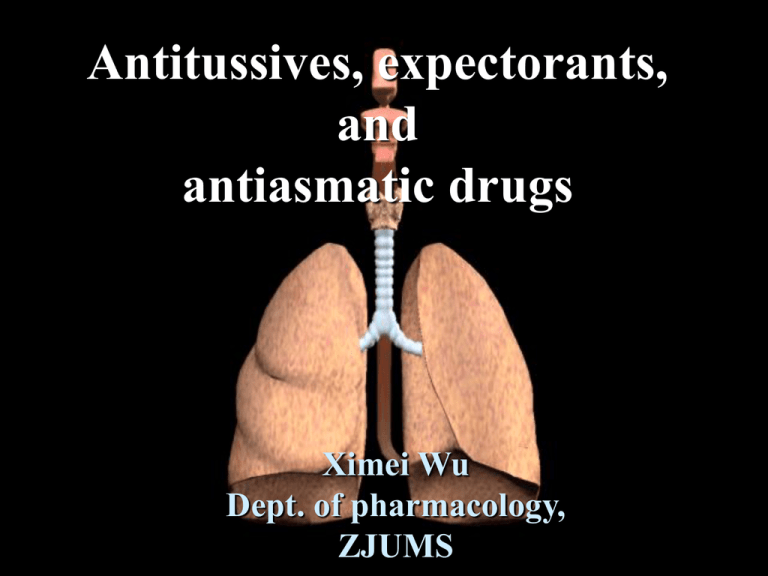
Antitussives, expectorants, and antiasmatic drugs Ximei Wu Dept. of pharmacology, ZJUMS Drugs acting on respiratory system • Cough • • antitussive drugs centrally acting peripherally acting • Sputum expectorant drugs • • sputum-diluting drugs mucolytic drugs • Asthma antiasthmatic drugs • • • • • • • bronchial dilators receptor agonists theophyllines muscarinic antagonists anti-inflammatory drugs glucocorticosteroids mediator release inhibitors 1. Antitussives • Centrally acting • • • • • Addictive drugs: codeine 可待因 Non-addictive drugs: dextromethorphan 右美沙芬 pentoxyverine 喷托维林(咳必清) • Peripherally acting • benzonatate 苯佐那酯 Codeine 可待因 H3CO O N HO CH 3 • 1. Pharmacological effects • suppression of cough • analgesia • 2. Clinical uses • Cough without sputum • 3. Adverse effects • Respiratory depression (at larger doses) • • Addiction Contraindicated in patients with thick sputum Dextromethorphan 右美沙芬 • 1. Pharmacological effects • • suppression of cough muscarinic and NMDA receptor antagonism • 2. Clinical uses • Upper respiratory infection, cough without sputum • 3. Adverse effects • • Atropine-like side effects Contraindicated in patients with glaucoma, pregnancy (< 3 m), psychotic disorders, etc. Pentoxyverine 喷托维林(咳必清) Pharmacological effects • Suppression of cough • Muscarinic antagonism and local anesthetic effects • Uses and adverse effects are similar to dextromethorphan Benzonatate 苯佐那酯 Pharmacological effects • • • • Peripherally acting Blocking cough reflex Local anesthetic effects CNS depression 2. Expectorants Sputum-diluting drugs Stimulating bronchial secretion Amonium chloride 氯化铵 Potassium iodide 碘化钾 Mucolytic drugs Bromhexine 溴己新 Ambroxol 氨溴索 Acetylcysteine 乙酰半胱氨酸 Methylcysteine 美司坦 Carbocisteine 羧甲司坦 Mesna 美司钠 3. Antiasthmatic drugs Asthma • Asthma is physiologically characterized by increased responsiveness of the trachea and bronchi to various stimuli and by widespread narrowing of the airways that changes in severity either spontaneously or as a result of therapy. • Its pathologic features are contraction of airway smooth muscle, mucosal thickening from edema and cellular infiltration, and inspiration in the airway lumen of abnormally thick, viscid plugs of mucus. Asthma • Symptom: dyspnea, wheezing, stridor, coughing, an inability for physical exertion. The cough may sometimes produce clear sputum. • Between episodes, most patients feel well but can have mild symptoms and they may remain short of breath after exercise for longer periods of time than the unaffected individual. Immunological and non-immunological stimuli inflammation bronchoconstriction 2 receptor agonists glucocorticosteroids disodium cromoglycate Theophylline muscerinic antagonists Airway hyperresponsiveness Wheezing (asthmatic symptoms) 1. Bronchial dilators Receptor agonists Non-selective:adrenaline, isoprotererol 2-selective: moderate-acting: salbutamol, terbutaline long-acting: salmeterol, formoterol Theophyllines: aminophylline Muscarinic antagonists: ipratropine 2. Anti-inflammatory drugs Glucocorticosteroids: Systemic: hydrocortisone, dexamethasone Inhalation: beclomethasone, budesonide Inhibitors of mediator release: cromolyn sodium, nedocromil Bronchial dilators 2 receptor selective agonists Salbuterol 沙丁胺醇 Terbutaline 特布他林 Salbuterol 沙丁胺醇 1. Pharmacological effects Relaxing bronchial smooth muscles 2. Clinical uses Controlling asthmatic symptoms Given by inhalation, oral or injection 3. Adverse effects Skeletal muscle tremor Cardiac stimulation (larger doses) Dysfunction of metabolism (hypokalemia, etc.) Selectivity of 2 agonists Aerosol inhalation less systemic toxicity 定量手控 气雾器 Spacer used for aerosol inhalation Spacer will aid patients inhale the aerosolized drugs easier 2 receptor selective agonists long-acting Formoterol Salmeterol Bronchial dilators Theophyllines Aminophylline -- -- O H3C N O -- . NH N CH3 CH2NH2 CH2NH2 N -- 2 . 2H2O Theophyllines 1. Pharmacological effects Bronchus dilation Inhibiting phosphodiesterase; Blocking adenosine receptors; Increasing catecholamine release; Immunomodulation; Increasing respiratory muscle contractility; CNS stimulation, diuretic, gastric acid secretion, etc. Theophyllines 2. Clinical uses Bronchial asthma (p.o., i.v.) Others: acute pulmonary edema, etc. 3. Adverse effects GI reactions CNS stimulation Acute toxication ( i.v. injection too rapidly ) tachycarida, arrhythmia, seizure, coma, death Bronchial dilators Muscarinic antagonists Ipratropine CH2 CH CH3 (CH3)2CHNCH3 CH CH2 CH CH3 O O C CH C6H5 CH2 OH • Relaxing bronchial smooth muscles • No effect on sputum secretion • Replaced with or combined with 2 receptor selective agonists Glucocorticosteroids Systemic (adverse effect): hydrocortisone prednisone dexamethasone Inhalation: beclomethasone dipropionate budesonide triamcinolone acetonide fluticasone propionate flunisolide Beclomethasone dipropionate CH2OCOC2H5 C HO OCOC2H5 CH3 Cl O O Beclomethasone dipropionate 1. Pharmacological effects (Antiinflammation) Inhibiting inflammatory cell activities, Antibody production, mediator release, Inhibit increased responsiveness of the trachea and bronchi 2. Clinical uses As first-line drugs, currently Controlling chronic symptoms Ineffective for acute symptoms Adverse effects • Local: oropharyngeal candidiasis-using spacer • Systemic effects • a) Hypercorticism-like syndrome: central obesity (moon face, buffalo hump, etc.); hypertension; glycosuria, hypokalemia; etc. • b) Increasing susceptibility to infections • c) Ingestive system: peptic ulcers, etc. • d) Cardiovascular system: hypertension, arteriosclerosis • e) Myopathy and osteoporosis: vertebral compression fractures, spontaneous fractures, especially in postmenopausal women • f) Adrenal suppression Inhibitors of mediator release Disodium cromoglycate ( cromolyn ) NaOOC O O O OCH2CHCH2O OH O COONa Disodium cromoglycate 1. Pharmacological effects Inhibiting mediator release from mast or other cells Inhibiting sensory neuropeptide release and nonspecific stimulus induced bronchus contraction 2. Clinical uses (only inhalation) Prevention of allergic asthma Acting slowly (2-4 weeks) 3. Adverse effects Oropharyngeal irritation Other inhibitors of mediator release • Nedocromil sodium: GI effect • Tranilast • Ketotifen (H1 receptor antagonist) Leukotriene pathway inhibitors • Airways LTC4, LTD4, LTE4----bronchoconstrictors, increase microvascular permeability, mucus secretion LTB4----chemoattractant for neutrophils • Leukotriene pathway inhibitors CysLT1 receptor antagonist (zafirlukast): for mild or moderate asthma, but not use alone for acute asthma 5-LOX inhibitor (zileuton)

